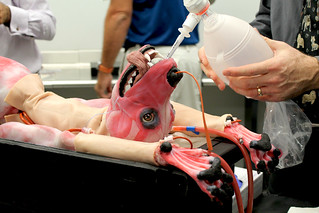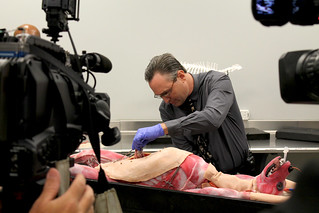http://e-info.org.tw/node/115933
終結動物實驗的第一步 「人工狗」全球首亮相
文字大小
2330 1 Share1
本報2016年6月3日綜合外電報導,姜唯編譯;蔡麗伶審校
機器人不稀奇,美國佛州一間生技公司上月31日發表專利技術,製造出全球第一隻「人工狗」。仔細一看,這隻人工狗不僅是一隻沒有皮膚的狗,更是極度精細、接近真實的手術訓練犬。專家指出,這項技術可望拯救數千隻生命,並改寫獸醫學教育。
SynDaver Labs發表全球第一隻人工狗。圖片來源:SynDaver Labs。
世界級人工人製造商SynDaver Labs發表人工犬計畫(SynDaver Synthetic Canine),並發起目標2400萬美元的群眾募資。可望踏出終結獸醫學校非存活手術(non-survival or terminal surgery)的第一步,也是終結動物實驗的第一步。
獸醫學校的非存活手術,讓學生以麻醉的流浪動物進行手術練習,結束後立即安樂死。
人工犬是以SynDaver專利的SynTissue人工組織製成,模擬活體組織,有完整的身體器官系統,可以模擬客製疾病和併發症。人工犬甚至有會跳動的心臟、循環系統,手術刀切下去時還會流血。獸醫學生修習解剖學,人工犬可說是正確且真實的手術練習工具。
除了人工犬外,這間公司還發起史上最具野心的群眾募資計劃。若達成募資目標2400萬美元,將免費提供全世界的認證獸醫學校每間最多20具人工狗。如此一來,將能有效減少非存活手術的必要。全美數千隻實驗動物可望因此受惠。
如果2400萬募資計劃達標,SynDaver接下來將開發人工貓,此外還有人工馬和人工牛的研發計畫。
SynDaver人工犬演示操作。來源:SynDaver Labs。
為了創造出最擬真的人工犬,SynDaver和佛羅里達大學獸醫學院密切合作。SynDaver的人工犬具有正確的解剖特性,有脂肪、筋膜、骨骼、肌肉、韌帶、完整可移動的關節和所有身體系統,受到獸醫學界專家肯定,甚至獲得人道獸醫學協會董事會成員布萊克維爾(Michael Blackwell)博士的支持。
雖然不再像過去那麼普遍,全美和全球許多獸醫學校仍依賴非存活手術進行教學。人工犬也能減少安樂死流浪動物,以獲取犬屍體的需求。
【相關文章】
【參考資料】
- SynDaver Labs(2016年5月31日),PHOTO RELEASE: SynDaver Labs unveils world’s first synthetic dog
PHOTO RELEASE: SynDaver Labs unveils world’s first synthetic dog

TAMPA, Fla. – (May 31, 2016) Dr. Christopher Sakezles, founder of SynDaver Labs, a Tampa-based biotechnology company, unveiled the SynDaver Synthetic Canine during a press conference at the company’s headquarters in Tampa, Florida on Tuesday. (Judge Public Relations photo handout by Justin Mayfield)
TAMPA, Fla. – A Tampa biotechnology company unveiled their latest creation on Tuesday, a new skinless breed of dog, which will result in thousands of animals being saved as it is distributed.
SynDaver Labs, the world’s leading manufacturer of synthetic humans, unveiled the SynDaver Synthetic Canine and launched a $24 million crowdfunding campaign. The campaign will begin to end a process known as terminal surgery labs. The product will immediately end the need for terminal surgery labs in veterinary medical schools and represents the beginning of the end of animal testing in general.
The SynDaver Synthetic Canine is not only a skinless dog, but rather an extremely detailed and realistic surgical trainer. It will provide veterinary students with an anatomically accurate and realistic platform to practice surgical procedures. Similar to the SynDaver Synthetic Human, the canine utilizes SynDaver’s patented SynTissue, which mimics living tissue, includes a full list of functioning bodily systems, and has the capability to simulate customized diseases, illnesses and medical complications. The synthetic dog even has a heart with a heartbeat, a circulatory system, and bleeds when surgical cuts are made.
In addition to launching the SynDaver Synthetic Canine, the company also announced the launch of one of the most ambitious crowdfunding campaigns in history. SynDaver hopes to raise $24 million through their campaign page on Indiegogo.com. If the company is successful with the campaign, SynDaver will provide up to 20 synthetic canines to each accredited veterinary college around the world, completely free of charge.
By providing each veterinary college with a full complement of their new synthetic canines at no cost, SynDaver will effectively eliminate the practice of terminal surgery labs. In veterinary medicine, terminal surgery labs involve teaching students how to perform certain surgeries on live, anesthetized shelter animals, and then euthanizing the animal immediately following the procedure. The SynDaver Synthetic Canine will also eliminate the need for canine cadavers, which are also typically euthanized animals from shelters.
While these kinds of labs are not as widely used as they once were, many veterinary colleges across the U.S. and around the globe still rely on terminal procedures to educate students.
“If we launched this product organically, it might take us a decade to put canine cadavers into every veterinary college and many more animals would die needlessly as a result,” said Dr. Christopher Sakezles, chief technology officer and founder of SynDaver Labs. “With the help of the crowdfunding campaign, we can do this practically overnight, and start to put an end to terminal labs for good.”
According to experts, this technology will save thousands of lives and revolutionize veterinary medicine education.
The SynDaver Synthetic Canine is similar to their human products. The canine models are anatomically accurate, with fat, fascia planes, all bones, muscles, ligaments, fully articulating joints, and each of the bodily systems. The product has been acclaimed by experts in the veterinary industry and has even garnered the support of Dr. Michael Blackwell, former chief veterinarian of the U.S. Public Health Service.
“A significant number of students do not care to be involved in terminal surgery procedures or the use of live animals when there is an alternative,” said Blackwell. “I am so happy to have this change because that is where we need to be today.”
SynDaver has been working closely with the University of Florida, College of Veterinary Medicine throughout the development of the SynDaver Synthetic Canine to create the most lifelike and realistic synthetic canine possible.
If SynDaver exceeds their $24 million crowdfunding goal, the company plans to begin working on the SynDaver Synthetic Feline next. There are also plans to develop synthetic horses and cows.
To learn more about ending terminal surgery labs, visitendterminallabs.com.
About SynDaver Labs
SynDaver Labs manufactures synthetic humans for training in schools, hospitals and military installations. SynDaver has the world’s largest database of live-tissue properties and all SynDaver tissues are made from water, salts, and fibers. The company currently has 10 patents on these materials, processes, and related products. SynDaver Labs is headquartered in Tampa, Florida and employs nearly 100 people. The company also has an advanced research facility located in Phoenix, Arizona and is planning additional facilities in the U.S., China, Europe, and Latin America.
SynDaver Labs manufactures synthetic humans for training in schools, hospitals and military installations. SynDaver has the world’s largest database of live-tissue properties and all SynDaver tissues are made from water, salts, and fibers. The company currently has 10 patents on these materials, processes, and related products. SynDaver Labs is headquartered in Tampa, Florida and employs nearly 100 people. The company also has an advanced research facility located in Phoenix, Arizona and is planning additional facilities in the U.S., China, Europe, and Latin America.
ALL PHOTOS AND VIDEOS BELOW ARE AUTHORIZED FOR MEDIA USE:
- TAMPA, Fla. – (May 31, 2016) SynDaver Labs, a Tampa-based biotechnology company unveiled the SynDaver Synthetic Canine in a press conference at their headquarters in Tampa, Florida on Tuesday. (Judge Public Relations photo handout by Justin Mayfield)
- TAMPA, Fla. – (May 31, 2016) SynDaver Labs, a Tampa-based biotechnology company unveiled the SynDaver Synthetic Canine in a press conference at their headquarters in Tampa, Florida on Tuesday. (Judge Public Relations photo handout by Justin Mayfield)
- TAMPA, Fla. – (May 31, 2016) Dr. Christopher Sakezles, founder of SynDaver Labs, a Tampa-based biotechnology company, unveiled the SynDaver Synthetic Canine during a press conference at their headquarters in Tampa, Florida on Tuesday. (Judge Public Relations photo handout by Justin Mayfield)
- TAMPA, Fla. – (May 31, 2016) SynDaver Labs, a Tampa-based biotechnology company, unveiled the SynDaver Synthetic Canine during a press conference at their headquarters in Tampa, Florida on Tuesday. (Judge Public Relations photo handout by Justin Mayfield)
- TAMPA, Fla. – (May 31, 2016) Dr. David Danielson, vice president of veterinary technology at SynDaver Labs, and Dr. Christopher Sakezles, founder of SynDaver Labs talk about the new SynDaver Synthetic Canine at a press conference at the company’s Tampa headquarters on Tuesday. (Judge Public Relations photo handout by Justin Mayfield)
- TAMPA, Fla. – (May 31, 2016) Dr. David Danielson, vice president of veterinary technology at SynDaver Labs, and Dr. Christopher Sakezles, founder of SynDaver Labs talk about the new SynDaver Synthetic Canine at a press conference at the company’s Tampa headquarters on Tuesday. (Judge Public Relations photo handout by Justin Mayfield)
- TAMPA, Fla. – (May 31, 2016) SynDaver Labs, a Tampa-based biotechnology company, unveiled the SynDaver Synthetic Canine during a press conference at their headquarters in Tampa, Florida on Tuesday. (Judge Public Relations photo handout by Justin Mayfield)
- TAMPA, Fla. – (May 31, 2016) SynDaver Labs, a Tampa-based biotechnology company, unveiled the SynDaver Synthetic Canine during a press conference at their headquarters in Tampa, Florida on Tuesday. (Judge Public Relations photo handout by Justin Mayfield)
- TAMPA, Fla. – (May 31, 2016) SynDaver Labs, a Tampa-based biotechnology company, unveiled the SynDaver Synthetic Canine during a press conference at their headquarters in Tampa, Florida on Tuesday. (Judge Public Relations photo handout by Justin Mayfield)
- TAMPA, Fla. – (May 31, 2016) SynDaver Labs, a Tampa-based biotechnology company, unveiled the SynDaver Synthetic Canine during a press conference at their headquarters in Tampa, Florida on Tuesday. (Judge Public Relations photo handout by Justin Mayfield)
- TAMPA, Fla. – (May 31, 2016) SynDaver Labs, a Tampa-based biotechnology company, unveiled the SynDaver Synthetic Canine during a press conference at their headquarters in Tampa, Florida on Tuesday. (Judge Public Relations photo handout by Justin Mayfield)
- TAMPA, Fla. – (May 31, 2016) SynDaver Labs, a Tampa-based biotechnology company, unveiled the SynDaver Synthetic Canine during a press conference at their headquarters in Tampa, Florida on Tuesday. (Judge Public Relations photo handout by Justin Mayfield)
- TAMPA, Fla. – (May 31, 2016) SynDaver Labs, a Tampa-based biotechnology company, unveiled the SynDaver Synthetic Canine during a press conference at their headquarters in Tampa, Florida on Tuesday. (Judge Public Relations photo handout by Justin Mayfield)
- TAMPA, Fla. – (May 31, 2016) SynDaver Labs, a Tampa-based biotechnology company, unveiled the SynDaver Synthetic Canine during a press conference at their headquarters in Tampa, Florida on Tuesday. (Judge Public Relations photo handout by Justin Mayfield)
- TAMPA, Fla. – (May 31, 2016) SynDaver Labs, a Tampa-based biotechnology company, unveiled the SynDaver Synthetic Canine during a press conference at their headquarters in Tampa, Florida on Tuesday. (Judge Public Relations photo handout by Justin Mayfield)
- TAMPA, Fla. – (May 31, 2016) SynDaver Labs, a Tampa-based biotechnology company, unveiled the SynDaver Synthetic Canine during a press conference at their headquarters in Tampa, Florida on Tuesday. (Judge Public Relations photo handout by Justin Mayfield)
- TAMPA, Fla. – (May 31, 2016) SynDaver Labs, a Tampa-based biotechnology company, unveiled the SynDaver Synthetic Canine during a press conference at their headquarters in Tampa, Florida on Tuesday. (Judge Public Relations photo handout by Justin Mayfield)
- TAMPA, Fla. – (May 31, 2016) SynDaver Labs, a Tampa-based biotechnology company, unveiled the SynDaver Synthetic Canine during a press conference at their headquarters in Tampa, Florida on Tuesday. (Judge Public Relations photo handout by Justin Mayfield)
- TAMPA, Fla. – (May 31, 2016) Dr. Christopher Sakezles, founder of SynDaver Labs, a Tampa-based biotechnology company, unveiled the SynDaver Synthetic Canine during a press conference at their headquarters in Tampa, Florida on Tuesday. (Judge Public Relations photo handout by Justin Mayfield)























沒有留言:
張貼留言